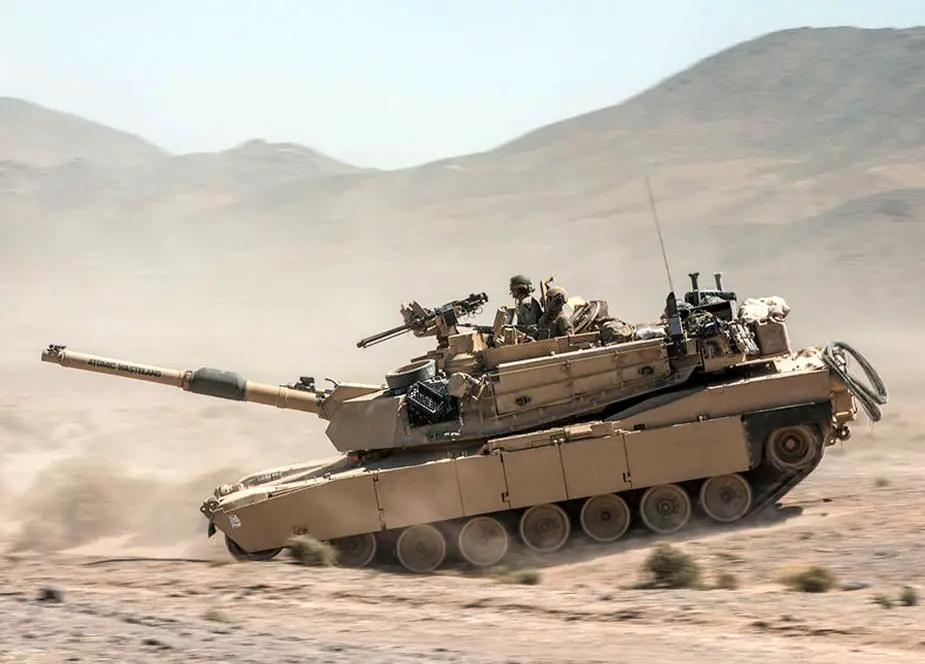U.S. Army training devices could soon be embedded in helicopters, vehicles
The U.S. Army plans to embed virtual system training capabilities into its future helicopters and next-generation combat vehicles, said a senior leader of the Army's Combined Arms Center. Joe Lacdan reports on U.S. Army’s website.

M1A2 Abrams, 2nd Armd Bde Combat Team, 1st Cav Div, Fort Irwin (Picture source: U.S. Army / Maj. Carson Petry)
The devices, still under development, would be mounted in the cockpits of aircraft and inside combat vehicles. They will help aviators and drivers become more efficient in their training, said Brig. Gen. Stephen Michael, deputy commanding general of CAC and Fort Leavenworth, Kansas, speaking at an Association of the U.S. Army "Hot Topic" forum on aviation, Sept. 5.
The technology will allow pilots and drivers to train inside their primary operating vehicles. Virtual embedded system trainers are already being used for the Integrated Visual Augmentation System, a single-platform, heads-up display that lets Soldiers train in realistic virtual environments. The Army expects to reach initial operating capability for the IVAS by the fourth quarter of fiscal 2021.
The synthetic training environment, an augmented virtual training platform, could further enhance Soldiers' opportunities to train at their home station or at combat training centers, said Larry Hamby, STE capability manager at CAC. The embedded system trainers will have a switch that activates the training simulations. "The intent is to reuse that STE software (and) have the virtual trainer in the future vertical lift platform and the next-generation combat vehicles," Hamby said. "The trainer is the actual piece of equipment. The pilot will be training in his platform doing his mission rehearsal, will be doing training in his actual aircraft."
To keep its competitive edge over near-peer adversaries, the Army has been preparing for large-scale ground combat operations, Michael said.
To help Soldiers achieve the Army's ambitious readiness goals, the service has made advances in its training. The Army Research Laboratory at Aberdeen Proving Ground, Maryland, and the Institute for Creative Technologies in Southern California have been developing the One World Terrain, a virtual training management tool that will eventually become a pillar of the synthetic training environment. OWT features augmented reality software that uses data collection and data mapping to create realistic training scenarios for Soldiers on the ground.
As the Army transitions from fighting anti-insurgency battles to large-scale ground combat operations, some Soldiers have already embraced the changes in training Army leaders said last Thursday.
Col. Kenneth Cole, the deputy commander at the Army's Aviation Center of Excellence at Fort Rucker, Alabama, recently completed a two-year stint as the 12th Combat Aviation Brigade commander in Ansbach, Germany, where he could see the change in Soldiers who transitioned to his unit in Western Europe. "The Soldiers are coming out already familiar with the concepts of large-scale combat operations," Cole said. "And the doctrine is being embedded into the programs of instruction all across the board."
One challenge the Army faces with its aviation platforms, including the AH-64 Apache and the CH-47 Chinook, is successfully creating realistic training scenarios in simulations that accurately depict the complexities of the aircraft, said Col. John Ferrell, director of simulation for the Aviation Center of Excellence. He said the aviation branch lags behind in training for each of the platforms as the service prepares for multi-domain operations -- in the air, land, space, cyberspace and sea. "Our simulations still do not replicate the complexity of MDO as described in the doctrine," he said. "Although we're doing the best that we can with the simulations we have."
When asked how the Army could improve its training, Michael said a focus on leader development and helping commanders drive training standards could help prepare Soldiers better. He added that the service could conduct better assessments of training programs and how Soldiers respond to the training.
Retired Gen. James D. Thurman, the former commander of both United Nations Command and Army Forces Command, suggested that the Army should return to having more standard operating procedures, along with concise training objectives. "That's what we did with the Apache program, everybody had one SOP," Thurman said. "That's the way we trained in the armored cavalry regiments in the old days. Everybody knew what was expected."
As the Army incorporates augmented reality and the synthetic training environment into its training procedures, Ferrell said that commanders must remain wary of augmented reality and virtual reality limitations.
While the synthetic training environment can replicate dense forests and even urban battlefield situations, even the most realistic virtual training program cannot always accurately render a real-world battle scenario. "Simulations do get better and better every year; how it replicates the real world is getting better and better," Ferrell said. "They are always limited. As a commander, as a trainer in the field, you've got to understand those limitations. You've got to employ the tools within that limitation."
Still, the general said that proficiency in multi-domain operations gives the Army the capability to solve complex problems with an array of methods, but maintaining the U.S. military's competitive edge over near-peer adversaries requires mastery of MDO.
To do so, the Army must enable brigades and divisions to be capable of earning certifications at their home station, he said, so they can remain one step ahead for advanced training. "So when you show up at a combat training center, it's not next to crawl, walk and run, but it's actually going to war against a thinking, breathing, enemy," Michael said. "And the combat centers can actually push you the way an enemy would."

























